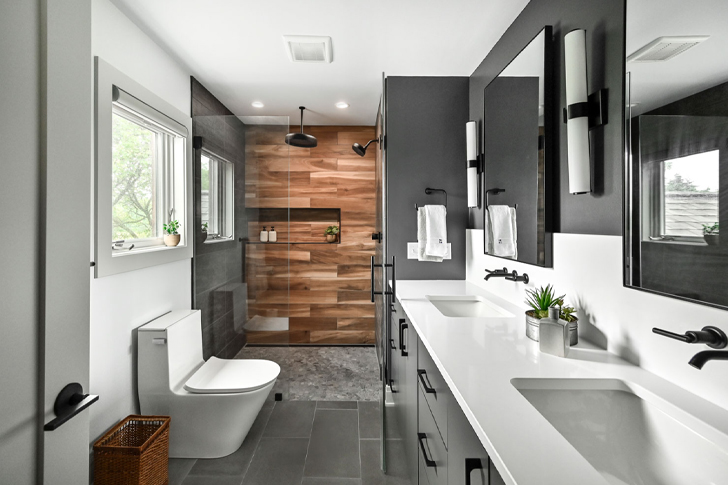Affordable Tips for Bathroom Remodeling
Bathroom remodeling can breathe new life into your home and add value to your property, but it can also be costly. However, with smart planning and strategic choices, you can renovate your bathroom on a budget without sacrificing style or quality. Here, we explore several affordable tips for upgrading your bathroom, ensuring that cost-efficiency does not come at the expense of aesthetics or functionality.

Tips for Budgeting and Planning
Effective budgeting lays the foundation for any successful remodeling project. First, assess how much you can realistically afford to spend. According to Remodeling Magazine’s 2021 Cost vs. Value report, the average cost of a midrange bathroom remodel is approximately $24,424, while an upscale remodel can climb to $75,692. However, with savvy budget management, you can significantly lower your expenses.
Once your budget is set, prioritize the changes that will make the most significant impact or are most necessary. Perhaps your tiles need replacing, or the fixtures have become outdated. Knowing where to allocate your funds will help you get the best return on your investment.
Updating Fixtures on a Budget
One of the most cost-effective ways to update your bathroom is to replace old fixtures such as faucets, showerheads, and even lighting fixtures. Modern fixtures not only enhance the look of your bathroom but also feature improved energy efficiency, which can help reduce your water and electricity bills. For instance, a high-efficiency shower head can save up to 2,900 gallons of water per year, according to the Environmental Protection Agency (EPA).
Furthermore, you don’t necessarily need to purchase from high-end brands. Many mid-range products offer similar features and aesthetics at a fraction of the cost. Shopping during sales or using discount coupons are additional ways to save.
Choosing Cost-Effective Materials
Regarding materials, you don’t always have to opt for top-of-the-line to achieve an appealing design and durability. For example, instead of natural stone tiles, consider porcelain or ceramic, which can mimic the look of stone or wood at a lower cost. According to HomeAdvisor, ceramic or porcelain tiles typically range between $0.50 and $15 per square foot, while natural stone tiles can cost between $5 and $20 per square foot.
Laminate countertops are another excellent way to save money without compromising style. Modern laminate materials can imitate the appearance of granite or marble and are considerably less expensive and easier to maintain.
Maximizing Space Without Major Reconstruction
Expanding a bathroom can be one of the most expensive parts of a remodel, involving extensive construction and plumbing alterations. To avoid these costs, consider ways to maximize your existing space. Installing shelving or cabinets can help you organize and declutter. Recessed medicine cabinets or shelves within shower spaces can also increase storage without requiring additional space.
Another tip is to use large mirrors to enhance the perception of space visually. Mirrors reflect light and create an illusion of depth, making bathrooms appear larger and more open without any structural changes.
DIY Where Possible
While some aspects of a bathroom remodel might require professional help, such as plumbing or electrical work, there are several tasks you can tackle yourself to save on labor costs. Painting, for example, is a straightforward project that can significantly change the look of your bathroom. According to DIY Network, you can save between 50% and 70% of what it would cost to hire a professional by doing it yourself.
Additionally, installing new hardware on cabinets, replacing towel bars, or updating light fixtures are all relatively simple DIY tasks that can have a big payoff aesthetically. Just be sure to do thorough research and prepare adequately before starting any DIY project to ensure a smooth process and professional-looking results.
Consider Refinishing Instead of Replacing
When fixtures or items show minor wear and tear but are still functionally sound, refinishing can be a cost-effective alternative to replacement. For instance, refinishing a bathtub can cost between $300 and $600, whereas a new tub can run between $400 to more than $8,000, excluding installation fees, as per Angie’s List. Refinishing is not only cheaper but it also conserves resources, making it a more environmentally friendly option.
Cabinetry can also be refreshed rather than replaced. New paint and updated hardware can transform old cabinets for less than $200, depending on the size and materials needed.
Final Thoughts
Bathroom remodeling doesn’t have to be an exorbitant venture. With a clear plan, budget mindfulness, and strategic choices, you can transform your space without draining your finances. Consider these tips as a guideline to help you navigate the decision-making process, ensuring that your remodeling project boosts both the aesthetics and functionality of your bathroom without a hefty price tag.







Recent Comments